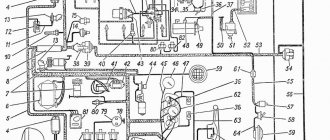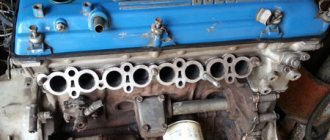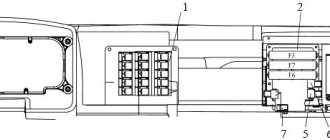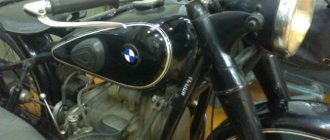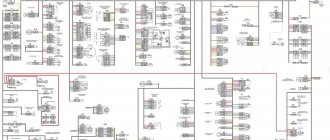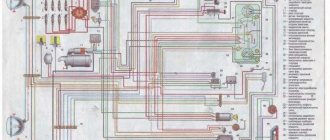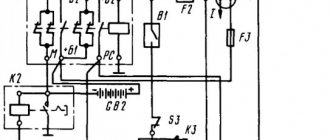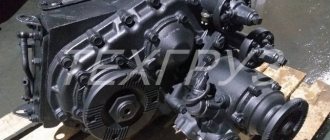As history shows, unified all-Union planning of the national economy also had its shortcomings. In particular, when the country needed a light-duty truck, domestic automakers did not have promising developments, and therefore ZIL was forced to borrow ideas from Mercedes.
Restyled ZIL 5301 – photo from the exhibition “Autotrans 2012”
Excursion into history
- We are, of course, talking about the “Bull” - a popular model of our days, built on the Mercedes T2 platform , and capable of solving any transport problems on short and medium routes.
- The reason for its appearance was the transition to a market economy in the Russian economy, as a result of which the demand for gasoline heavy-duty vehicles fell catastrophically.
- And thanks to the new model, the plant managed to survive and even increase production volumes, benefiting from government support.
For reference: Industry index - received 5301 cars by mistake. According to GOST from 1966, “Bychok” had to have an index of 3301, corresponding to the small-tonnage class. However, when drawing up the certificate, an unfortunate mistake was made, which, when discovered, was too late to correct anything, because All documentation for the car already indicated the index 5301.
Summary
Despite the difficult market times, the automaker was able to offer a new truck that allowed it to withstand difficult economic conditions. And although domestic cars are not of high build quality, a variety of modifications of the ZIL 5301 are still in service in many cities and villages.
We hope that your car will serve for a long time, and the materials and photographs proposed in the article will help in its independent maintenance. Good luck on the roads!
Did you like the article? Follow our channel for new ideas of useful car tips. Subscribe to us in Yandex.Zen. Subscribe.
Specializing in the production of medium-duty trucks, AMO ZIL in the mid-90s faced a sharp decline in demand for its products. The reason for this is the political and economic processes in the USSR, which prompted the automaker to refocus on the production of a completely new class of trucks - the light-duty ZIL 5301.
Model features
Main modifications of the ZIL 5301 according to factory documentation
According to the manufacturer, the vehicle’s design served as a platform for 35 modifications for various purposes. The photo above shows the factory instructions.
It should be noted that most modifications were ordered:
- state companies;
- public utilities;
which allowed the plant to load production capacity. The presented video shows only some of the modifications of this model found on domestic roads.
At the same time, to reduce the cost of the car, the manufacturer used components and assemblies from other models, for example, the electrical wiring of the ZIL 4331, since the high price of a car with original parts developed from scratch would not allow it to compete in market conditions.
In particular, the following were installed on the Bychok:
- The cabin is from model 4331. Along with it, the ZIL 4331 wiring and power steering migrated;
- Gearbox ZIL 130.
All features of the electrical circuit are described in the instruction manual
Power units
The automaker owes the success of the ZIL 5301 model primarily to the D-245 diesel engine , which was a modification of the 4,750 cm³ tractor 4-cylinder power unit produced by the Minsk Motor Plant.
Other domestic manufacturers also faced the search for a good engine for their cars. You can read about this in the article - Moskvich 2141: discussing features.
Over the years of production, the Bychok car was equipped with:
- Until 2005 - modernized MMZ D-245.9 and MMZ D-245.12S, corresponding to EURO-0;
- Since 2005 - diesel power unit MMZ D-245.9 corresponding to EURO-2;
- Since 2008 - MMZ D-245.9, meeting EURO-3 requirements .
Engine D245.12S-231 MMZ
Note! The power unit shown in the photo is often used for do-it-yourself conversion of ZIL-130/131 vehicles.
For such work, you will need a ZIL 131 wiring diagram, which you can find in the section of the site of the same name.
Electrical equipment
The ZIL Bychok wiring diagram uses a classic one. Below is a color illustration, divided into 2 parts for ease of printing. The required KAMAZ 5511 wiring diagram is laid out in a similar way, which you can also download and print.
Colored original electrical diagram ZIL 5301
It should be noted that in most cases, the ZIL Bychok wiring diagram did not cause any complaints when used carefully, although this fact was often reinforced by the care of the owners who serviced the car themselves.
Part two of the ZIL 5301 electrical equipment diagram
ZIL 5301 car diagram
Explanations for the diagram:
1 — front direction indicators left 4619.3726 and right 4609.3726;
5 - electric sound signal 20.3721-01 or S3-3B;
9 — coolant overheat indicator sensor TM111;
13 – generator 2022.3771;
19 — coolant level indicator sensor DKU1.M;
23 — electronic unit of fan speed controller ROV2.MS;
27 — electric motor of the windshield wiper 35.5205;
32 – voltage regulator 42.3702 or 206-3702 or 207.3702;
39 and 86 - side middle marker lights 43.3731;
46 - push-button thermobimetallic fuse for 20 A129.3722;
57, 110 and 113 - connecting panels;
61 — relay for turning on the spark plug of the electric torch device 111.3747 or 90.3747, or 851.3747;
65 — thermal relay of the electric torch device 12.3741;
69 — generator set status indicator;
74 — oil pressure drop indicator 2202.3803-23;
79 — indicator of reserve fuel level 2202.3803-19;
85 — remote battery switch 11.3704;
90 — control unit for electric corrector BUK021;
94 — wiper switch 9912.3709;
98 — rear fog lamp switch 3832.3710-02.04;
103 — cockpit canopy PK142;
107 and 120 — side rear marker lights 43.3731;
112 — license plate lights FP134;
2 — headlights 6002/6012.3711 or 68/681.3711;
6 and 14 — side front marker lights 43.3731;
10 — coolant temperature sensor TM100-V or 2442.38.28 or TM100V-01 or TM100V-K;
16 — oil pressure indicator sensor 18.3829 or MM355;
20 — electric motor 11.5208 windshield washer;
24 — electric motor of the ME272-B cabin heater;
28 — starter starting contactor 59.3747;
33 - starter 20.3708 or ST142N;
40 — breaker RS950С direction indicators;
48 - push-button thermobimetallic fuse 30 A 291.3722;
58 — starter automatic shutdown relay 111.3747-10 or 90.3747-22 or 853.3747;
62 — relay for fog lights and rear fog light 111.3747, or 90.3747, or 851.3747;
66 — RS492 parking brake warning switch;
70 — instrument cluster 36.3801;
75 — signaling device for switching on the electric torch device 2202.3803-17;
80 – brake system fault buzzer 733.3747-01;
87 — speedometer 48.3802;
91 — electronic control unit for windshield wiper and washer 92.3761 (installed on the bus);
95 — switch 20.3704 for instruments and starter;
99 — switch for heating elements of rear-view mirrors 3802.3710-02.23;
108 and 118 — rear marker lights 35.3731;
3 — electric drive for headlight range control EPKO22;
7 and 15 — side direction indicator lights 5702.3726;
11 - fuel shut-off electromagnet;
17- air filter clogging indicator sensor 13.3839;
21 and 34 — engine compartment lamps PD308-A;
25 — front contour lights 36.3731;
29 — brake signal switches for front and rear brakes 2802.3829 or 3402.3829;
35,37,53,54,55,56,71,77, 102 and 119 - connecting terminals;
41, 43, 44 45 and 47 - push-button thermobimetallic fuses for 10 A 292.3702;
49 and 50 - blocks of thermobimetallic push-button fuses 13.3722-01 for 7.5 Ax2; 51, 82 and 183 - fuses, respectively 2 A PR118B-01, 6 A PRII9-01 and 10APR119B-01;
59 — windshield wiper control relay 111.3747 or 90.3747;
63 — brake signal relay 111.3747, or 90.3747, or 851.3747;
67 — cabin heater switch 11147-04.11;
72 — air filter clogging indicator 2202.3803-20;
76 — block of brake system control indicators 2302.3803-21;
81 — hazard warning light switch 24.3710;
88 — high beam headlight indicator;
92 — portable lamp socket 47K-0;
96 — electric torch switch 11.3704-01;
100 — 6ST-11OAZ batteries;
104 — reverse light switch V3X-1 or VK403 or 5217.3710 or V12.3710;
105 — remote battery switch 1312.3737;
109 and 114—left and right rear lights 1711.3716 or 1102.3736, respectively;
115 - parking brake indicator sensor MMI 24d or 2702.3829;
116 — switch signaling a critical drop in the brake fluid level in the rear axle hydraulic brake reservoir;
121 - anti-theft relay 111.3747, or 90.3747, or 851.3747
4 — fog lights FG 152-AB;
8 — anti-theft device switch 2802.3829 or 3402.3829;
12 — spark plug of the electric torch device EFP-8101500;
18 - emergency oil pressure indicator sensor 2602.3829 or B10.3829 or 3202.3829 or DE-M;
22 and 38 — mirror heaters;
26 - transformer-rectifier unit 1212.3759 or 3797.001;
30 and 31 — air pressure drop sensors in the front and rear brake circuits 2702.3829;
36 — switch for signaling a critical drop in the level of brake fluid in the hydraulic reservoir of the front axle brakes;
What kind of converter is it, why is it included in the generator circuit?
In order to make the starter lighter, it is designed for a voltage of 24 V. In this case, with the same power, it consumes less current, which means the long wires that go to it from the battery can be made thinner. Everything becomes more reliable, contacts, brushes, retractors.
24 Volts are obtained by connecting two batteries in series. In order to charge the second battery, you need to apply a voltage exceeding 24 V to them. This voltage is obtained by doubling the generator voltage. The converter receives alternating voltage from the generator and produces its voltage of 14 V. It can be added to the generator voltage and the result is 28 V.
Is it possible to install a simple generator from Gazelle on the Bychok?
If you install a 12 Volt starter, and this option is quite possible, since for the D 242 engine all offered types of starters have both 12 Volt and 24 Volt versions. The 28 Volt voltage is no longer needed, there is no need for a converter, there is no need for alternating voltage outputs from the generator, which means any generator in such a housing will do.
A powerful starter will still require two batteries, but in this case they need to be connected in parallel.
The converter is no longer needed and no AC outputs are needed. The light on the instrument panel needs to be bypassed; charging can be monitored using a voltmeter.
Source
Converter 12V-24V
The converter that allows you to get 24 Volts to charge the second battery is a transformer and a diode bridge, the same as in the generator only without additional ones. diodes.
The transformer does not increase the voltage, its transformation ratio is 1 - as much as is supplied, so much is removed, but what is important here is that the transformer transmits energy through a magnetic field and decouples electrical circuits. The voltage obtained from the converter can be applied sequentially to the voltage from the output of the generator and they add up, so the output is 24 Volts, or rather double the output voltage of the generator.
How to change the wiring on Zyl Byk from 24 to 12 volts. )))))))) )))))))) | Topic author: Svetlana
Alina Compare two schemes. 24 and 12. Cut off the excess wires and lay the missing ones. All.
Vyacheslav Zabey. Seriously. Remodel and change EVERYTHING! including alternator, starter, dash, lights, ALL wiring, etc.
Peter What for? This will add to the price of a used car, and there is absolutely no reason
Do not interfere with the operation of a properly functioning device.
Evgeniya Replace the generator.
alterations | "BULL" is the best car. | In contact with
Checking the oil level in the automatic transmission of Volkswagen Golf 3
Source
"Bull" all-wheel drive and all-control
In September 1996, when I took these pictures, the ZIL-5301 was still considered a promising car, it received some kind of design prize, and many modifications were made to it, including a bus version.
